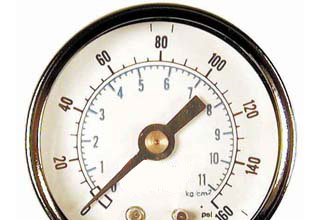 The following is a letter received by the Compressed Air Challenge from a concerned individual. Queries such as these are common if someone attends a CAC seminar.
The following is a letter received by the Compressed Air Challenge from a concerned individual. Queries such as these are common if someone attends a CAC seminar.
Question: We have a new maintenance supervisor that has turned down our shop air pressure to 86 psi, supposedly saving operating cost. My opinion is it should be set between 90 and 100 psi to accommodate surges. Is there really a significant savings by turning the supply down to 86 psi?
-A concerned electrical controls programmer
Answer:
Dear Concerned,
Yes indeed, lowering discharge pressure reduces the compressor motor power by about 1% for every 2 psi of lower pressure. Also, the lower pressure makes any unregulated uses in the ”shop” reduce consumption (cfm) by almost 1% for every one psi of pressure reduction. You will achieve extra savings if your compressor control systems can turn down compressor power in response to reduced flow or unload and possibly shut off unnecessary compressors.
The best pressure at which to set your system is the level your production can operate efficiently and effectively without waste; there is no right pressure, it depends on your machines. That being said, often you may have 90 to 100 psig at the compressor, but at the production machine, where the actual work is being done. you could have only 65 to 70 psig. In some cases, it may be even lower due to pressure drops in undersized piping, filters, regulators, lubricators and tubing and connectors. The goal is to lower compressor discharge pressure, without affecting the end users. The method is to address these pressure differentials and get the pressure to the machines with minimal loss; then the compressor discharge pressure may be reduced even more. This is typically a job for a controls programmer like you.
Having artificially high plant pressure can help you deal with surges in compressed air demand that might occasionally cause low pressure and affect production. The higher pressure acts to store reserve air in the various volumes made up of receivers, pipes and such in your system. However, the higher pressure costs more to produce and makes unregulated end uses consume more air, which is an expensive trade off. Another strategy might be to use a pressure/flow controller and large storage receiver capacity in the compressor room. This will supply stored air for surges, but maintain lower plant pressures to reduce artificial demand caused by elevated pressures. Your compressed air service provider can assist with implementing this.
If you want to learn more about optimizing your system download the free resource “Improving Compressed Air Performance: A Sourcebook for Industry” written by the Compressed Air Challenge and the Department of Energy. Also check out the Compressed Air Best Practices Manual.
You may be interested in learning more in the Compressed Air Challenge’s upcoming November 5th webinar on compressed air Fundamentals seminar—or the many in-person seminars across the country.
By Ron Marshall for the Compressed Air Challenge.

Very interesting question. I’m sure 86 was the ideal pressure at the last plant of that supervisor and the pressure here may well have been moved back up in the past month. Turning down the pressure may be counter productive on the cost end depending on the operating characteristics of the individual compressor. Some compressors operate more efficiently at higher pressures and in this case to achieve the lowest compressor operating costs it may be advisable to operate at the higher pressure. That being said, every leak will leak more at higher pressure. Every function will be most efficient with a properly sized regulator providing just the right amount of air (minimum pressure) to perform the action or a electronic valve that stops the air flow when the final position is reached. Besides leaks, continuing to pump air into stalled actuators is one of the biggest non value added consumers of plant compressed air.
I had a new safety officer on site who said we needed to have regulators on all lines set at 90psi.. Is this regulated by WorksafeBC? Some of our hand held equipment works better with a higher psi setting.
Having been retired for a lot of years I believe that OSHA still has limits for shop air. If you want to operate a piece of your own design I suggest that you see an engineer.
I was one for design of specific components for aircraft and designing our hydraulic/pneumatic test lab. But not any more. I’ll leave you with the safety agency and your research.
“ Good luck” has no place with high pressure shop air nor does an unqualified “I Think . . . ..”